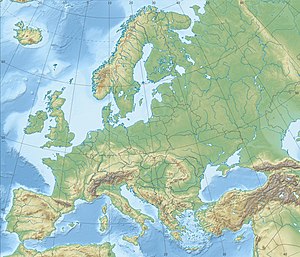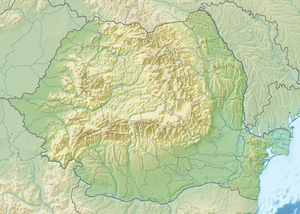The siege of Giurgiu[b] was a military siege undertaken by Russia between 17 and 24 February 1771 against the Ottoman city of Giurgiu. The siege was part of the Russo-Turkish War (1768–1774), and resulted in a Russian victory.
| Siege of Giurgiu (1771) | |||||||||
|---|---|---|---|---|---|---|---|---|---|
| Part of the Russo-Turkish War (1768–1774) | |||||||||
| |||||||||
| Belligerents | |||||||||
|
|
| ||||||||
| Commanders and leaders | |||||||||
| Unknown |
| ||||||||
| Strength | |||||||||
| Thousands |
| ||||||||
| Casualties and losses | |||||||||
| 4,000 killed[a] |
173 killed 794 wounded | ||||||||
Location within Europe | |||||||||
Prelude
editThe Turks were rapidly building up their military presence in Vidin and Turnu in January and February 1771; possibly aiming to attack the Russian-occupied cities of Oltenița and Craiova, and from there, reinforcing the garrison of Giurgiu. This was a great threat to Pyotr Olitz's forces stationed at Bucharest. Thus, Pyotr Rumyantsev directed Mikhail Krechetnikov to carry out a diversionary maneuver across the Olt and Danube rivers toward Vidin, while he instructed Olitz to advance on Giurgiu. Rumyantsev believed it was an opportune moment to seize Giurgiu, given that the Turks were busy dealing with Russian raids.[3]
Siege
editPyotr Olitz marched onto Giurgiu with 3,130 regular infantry and 347 cavalry. In addition, he had some Cossacks and Wallachian arnauts (Albanians) under his command. Olitz was not well-supplied, however, as he did not have enough siege guns. He was also very ill, which slowed him down and allowed for the Ottomans to reinforce the garrison of Giurgiu. Olitz reached the city on 17 February 1771, and learned that the Ottoman force was three times larger than theirs. On the 18th, he was able to repel a sortie by an Ottoman cavalry. Following this, Olitz ordered Brigadier Nikolai Saltykov to seize the outer trench line with a force composed of cavalry and jägers. However, by night, Saltykov came under attack by a Turkish sortie. He was almost killed and his battalion was almost entirely destroyed in the ensuing battle.[4]
Olitz stormed Giurgiu on the night of the 20th, entering into the 21st. Four columns of Russian troops entered the city, with two advancing from the suburb and two from the right flank. Their advance was impeded by a lack of fascines and ladders, but after three hours of fighting, the Ottoman defenders of the outer wall retreated into the citadel. For the next three days, the castle's 84 cannons and mortars, along with Olitz's three batteries positioned along the riverbank and facing the citadel bridge, were engaged in almost non-stop conflicts. After the citadel's gunpowder vault exploded, most of the garrison was killed and they ultimately capitulated on 24 February. 2,000 Turkish soldiers were allowed to leave, along with a hundred of Joachim Karol Potocki's Polish Confederates. 4,000 Turks died from the siege (most from the explosion), while another 2,000 managed to escape further up the Danube. Olitz's corps also suffered significant losses; 173 were killed and 794 wounded, including Major-Generals Ivan Gudovich,[5] Joseph Demolino, and Grotenhelm.[2]
Aftermath
editLeaving Second-Major Genzel in charge of Giurgiu with 600 men, Pyotr Olitz returned to Bucharest on 1 March. On 2 April, he was replaced by Ivan Gudovich as the commander of the Wallachian Corps of the Russian army. Olitz died only five days later in Bucharest.[2]
Giurgiu was taken back by the Turks after a siege between 27 and 29 May 1771.[6] Even if Reinhold-Wilhelm Ivanovich von Essen attempted to reclaim the city by storming it on 7 August, he was unsuccessful.[7] The final engagement in Giurgiu during the Russo-Turkish War (1768–1774) was a battle on 12 September 1771, which ended with an Ottoman victory.[8]
Notes
editCitations
edit- ^ Iorga, Nicolae (2024) [1908]. Afyoncu, Erhan (ed.). Osmanlı İmparatorluğu Tarihi 1300–1912 [History of the Ottoman Empire 1300-1912] (PDF) (in Turkish). Vol. 1–5. Translated by Epçeli, Nilüfer. Istanbul: Yeditepe Yayınevi. p. 1546. ISBN 9786258260717.
- ^ a b c Davies 2016, p. 168.
- ^ Davies 2016, p. 167.
- ^ Davies 2016, pp. 167–168.
- ^ Russkii Biograficheskii Slovar’, c. 1910. Trans. by Mark Conrad, 2001.
- ^ Davies 2016, pp. 168–169.
- ^ Nikolaevich, Petrov A. (1893). Влияние турецких войн с половины прошлого столетия на развитие русского военного искусства [The Influence of the Turkish Wars since the Middle of the Last Century on the Development of Russian Military Art] (in Russian). Vol. 1. Saint Petersburg. pp. 265–266.
{{cite book}}: CS1 maint: location missing publisher (link) - ^ von Hammer-Purgstall, Joseph. Çevik, Mümin (ed.). Büyük Osmanlı Tarihi [Great Ottoman History] (in Turkish). Vol. 16. Translated by Özdek, Refik. Istanbul: Üçdal Neşriyat. p. 186.
References
edit- Davies, Brian L. (2016). The Russo-Turkish War, 1768–1774: Catherine II and the Ottoman Empire. London: Bloomsbury Publishing. ISBN 9781472512932.

